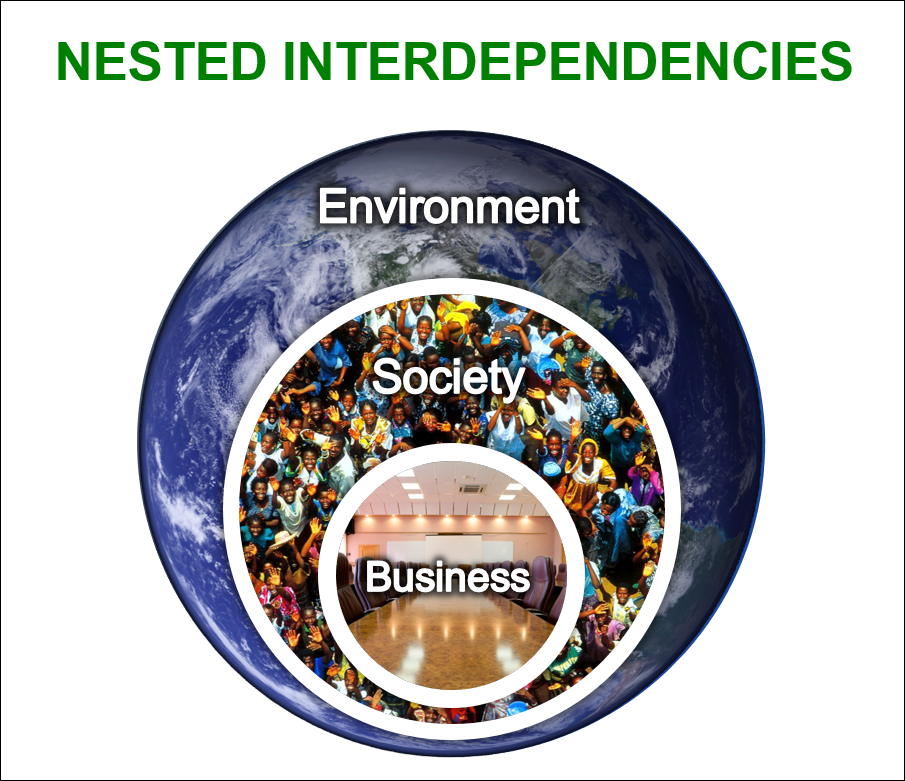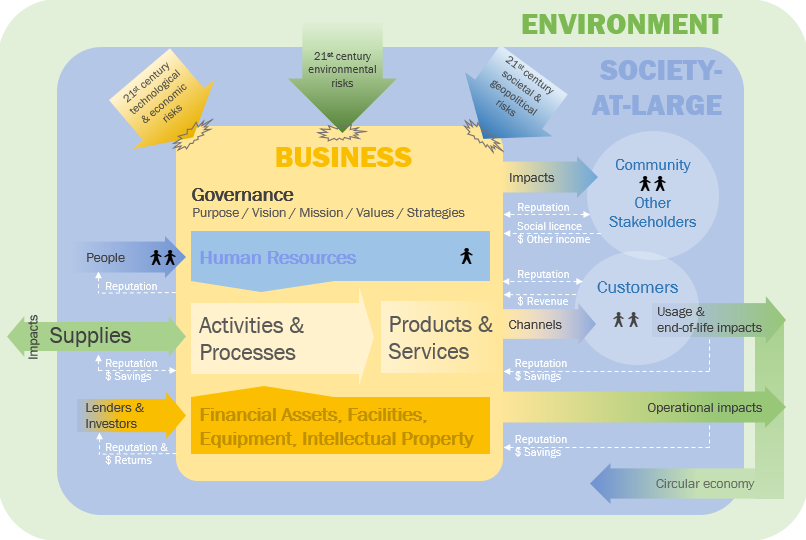3 Reasons To Upgrade To ES2B Business Models
Most business models are out of date. They lack a systems perspective. Today’s business models omit the surrounding environment and society-at-large. They suggest no accountability for long-term impacts on the nests by company operations, by use of company products and by the ultimate disposition of its products. Classical business models treat impacts on the environment and society-at-large as externalities that are beyond the purview of company accountability. Doing business on today’s crowded, depleted planet requires more complete business models that are fit-for-purpose in the 21st century. There are 3 reasons to upgrade to ES2B business models that better reflect systemic environment-and-society-to-business dynamics.
1. Classic business models do not reflect today’s reality on a finite planet
You’ve heard about the business-to-consumer (B2C) economy and the business-to-business (B2B) economy. It’s time to acknowledge the overarching environment-and-society-to-business (ES2B) economy. It’s the real one and it applies at both global and company levels
I often use the above nested interdependencies figure when doing a sustainability refresher at the beginning of presentations. Occasionally someone asks, “Shouldn’t the middle nest be labelled Economy, not Business?” or “Shouldn’t there be a fourth nest – Economy – between Society and Business?” Those suggestions might be appropriate ways to represent the B2B and B2C sub-economies, respectively. However, it’s time we acknowledged that all the “Bs” are themselves part of the real ES2B economy. The nested interdependencies figure illustrates how things work within the boundaries of our finite planet. It reinforces that businesses are dependent on a healthy environment and society-at large, so they merit inclusion in company business models.
2. Out-of-date business models mask new risks
The World Economic Forum (WEF) Global Risks 2019 report rates environmental factors as highest-impact / highest-likelihood threats to economies and businesses within the next ten years. The environmental risk at the center of the web of interrelated threats is the failure of climate change mitigation and adaptation. If a company’s business model does not include environment-related risks in its enterprise risk management processes, it can be blindsided by imminent threats like the climate crisis. An incomplete business model can be a deceiving security blanket.
Society and business are wholly owned subsidiaries of the environment. If the holding company goes out of business, businesses go out of business. However, since the beginning of the industrial revolution, businesses have carelessly polluted and abused the holding company. The cumulative effect has led to the environment being so damaged that it is impacting business, directly and indirectly. Current business models mask those boomeranging impacts by not acknowledging a company’s dependence on the finite environment. They hide the need for companies to take into account the impacts of environmental, societal, geopolitical, technological and economic risks identified in the WEF Global Risks report. An ES2B business model unmasks the dangers so that companies can mitigate those 21st century risks.
3. Current business models omit impact points
There are four categories of vital ecosystem services: provisioning services that provide us with materials, food and water; regulating services like climate, water and erosion regulation; supporting services like photosynthesis, pollination and nutrient recycling; and cultural services that support emotional health, spiritual values and recreation. Because the environment provides them for free, we take ecosystem service for granted … until they fail. This year, the Intergovernmental Panel on Biodiversity and Ecosystem Services (IPBES) warned that “we are eroding the very foundations of our economies, livelihoods, food security, health and quality of life worldwide.” The IPBES found that 65% of vital ecosystem services are in decline.
Why? Current business models don’t acknowledge a business’s impacts on the environment and society. The impacts are deemed to be non-financial externalities, so they are not worth tracking. Today, concerned stakeholders are holding companies accountable for their environmental and societal harm and demanding that they internalize their externalities. There are multiple places that a company impacts stakeholders, society and the environment. Unless the impact points are identified and assessed, a company won’t know which deserve the most attention. Companies can’t afford to waste resources on low priority issues.
It’s time to upgrade to ES2B business models to make dependence on the finite environment and society-at-large nests more explicit, to acknowledge new 21st risks and to identify where and how a company impacts the environment and society. The resulting comprehensive business model might look like this ES2B business model template:
The model is a rectangular, closeup, business-level version of the nested interdependencies global figure. Companies that already have business model figures can readily upgrade them to explicitly include environmental and society nests, the external risks and the impact points. It doesn’t matter what the model is called – “ES2B business model,” “sustainable business model,” “flourishing business model,” “21st century business model,” “B Corp business model,” “future-fit business model,” or “company x business model.” It’s what’s inside that counts, not the label.
The purpose of a 21st century business is to maximize stakeholder wellbeing. The bonus of this updated reality-based business model is that it can be used as the centerpiece for more complete reporting on how well the business is fulfilling its purpose. It mirrors the mindset required to manage financial performance as well as non-financial impacts on the wellbeing of key stakeholders. More on that soon …
Please feel free to add your comments and questions using the “Leave a reply” comment box under the “Share this entry” social media symbols, below. For email subscribers, please click here to visit my site and provide feedback. Slides shown are my Master Slide Decks, to which anyone can subscribe.






Comments are closed.